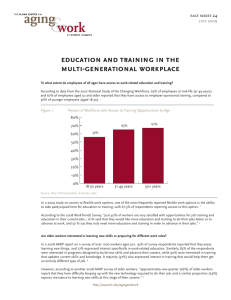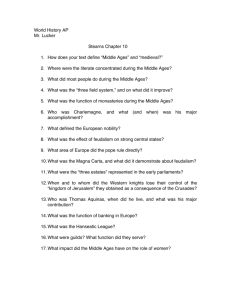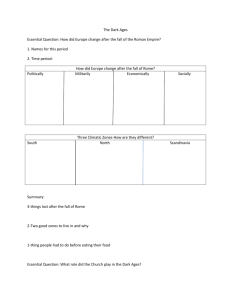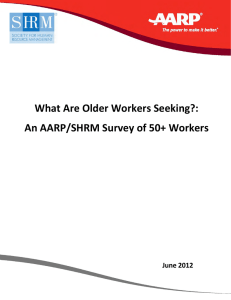Mental Health Fact Sheet 12 September, 2007
advertisement
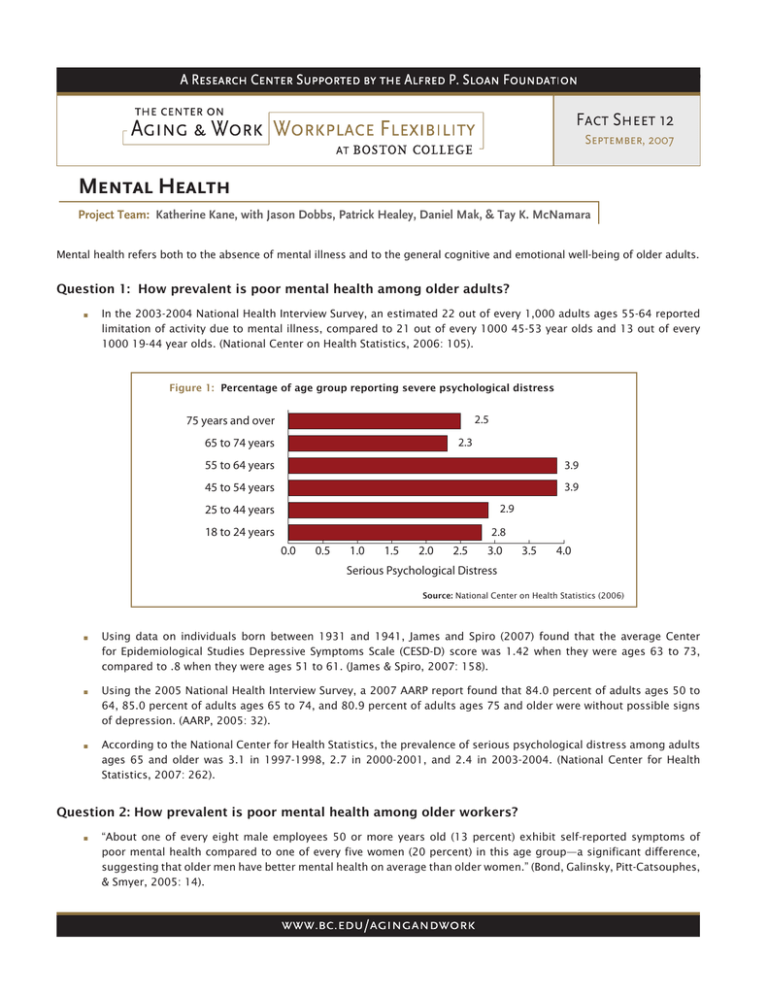
Fact Sheet 12 September, 2007 Mental Health Project Team: Katherine Kane, with Jason Dobbs, Patrick Healey, Daniel Mak, & Tay K. McNamara Mental health refers both to the absence of mental illness and to the general cognitive and emotional well-being of older adults. Question 1: How prevalent is poor mental health among older adults? � In the 2003-2004 National Health Interview Survey, an estimated 22 out of every 1,000 adults ages 55-64 reported limitation of activity due to mental illness, compared to 21 out of every 1000 45-53 year olds and 13 out of every 1000 19-44 year olds. (National Center on Health Statistics, 2006: 105). Figure 1: Percentage of age group reporting severe psychological distress 2.5 75 years and over 2.3 65 to 74 years 55 to 64 years 3.9 45 to 54 years 3.9 2.9 25 to 44 years 18 to 24 years 2.8 0.0 0.5 1.0 1.5 2.0 2.5 3.0 3.5 4.0 Serious Psychological Distress Source: National Center on Health Statistics (2006) � Using data on individuals born between 1931 and 1941, James and Spiro (2007) found that the average Center for Epidemiological Studies Depressive Symptoms Scale (CESD-D) score was 1.42 when they were ages 63 to 73, compared to .8 when they were ages 51 to 61. (James & Spiro, 2007: 158). � Using the 2005 National Health Interview Survey, a 2007 AARP report found that 84.0 percent of adults ages 50 to 64, 85.0 percent of adults ages 65 to 74, and 80.9 percent of adults ages 75 and older were without possible signs of depression. (AARP, 2005: 32). � According to the National Center for Health Statistics, the prevalence of serious psychological distress among adults ages 65 and older was 3.1 in 1997-1998, 2.7 in 2000-2001, and 2.4 in 2003-2004. (National Center for Health Statistics, 2007: 262). Question 2: How prevalent is poor mental health among older workers? � “About one of every eight male employees 50 or more years old (13 percent) exhibit self-reported symptoms of poor mental health compared to one of every five women (20 percent) in this age group—a significant difference, suggesting that older men have better mental health on average than older women.” (Bond, Galinsky, Pitt-Catsouphes, & Smyer, 2005: 14). � “When compared with employees under 50 years old, older employees are significantly less likely to exhibit symptoms of poor mental health (17 percent of older employees versus 28 percent of younger employees).” (Bond et al., 2005: 14). Question 3: What is the relationship between work and mental health? � According to the “Attitudes of individuals 50 and older toward phased retirement” survey conducted by the AARP, “... the desire to stay mentally active (72%) and the desire to remain productive and useful (71%) were the issues most frequently identified by workers 66+ as major reasons for working in retirement.” (AARP, 2005: 7). � Using the Health and Retirement Study Data, James and Spiro (2007) found that, among men ages 63 to 73, the disabled had average depression levels (abbreviated CES-D) of 2.4, compared to 1.4 for the retired, 1.5 for those working part-time, and 1.0 for those working full time. (James & Spiro, 2007: 160). � Using the Health and Retirement Study Data, James and Spiro (2007) found that, among women ages 63 to 73, the disabled had average depression levels (abbreviated CES-D) of 3.1, compared to 2.0 for the retired, 1.3 for those working part-time, and 1.5 for those working full time. (James & Spiro, 2007: 161). Figure 2: Average depression score for adults ages 63 to 73, by work status Retired 2 1.4 Unemployed 2.1 1.6 1.3 Working part time Working full time 1.5 1.5 1 Disabled 3.1 2.4 0.0 0.5 1.0 1.5 Men 2.0 2.5 3.0 3.5 Women Source: James and Spiro (2007) References: AARP. (2005, March). Attitudes of individuals 50 and older toward phased retirement (Research report). Washington, DC: Brown, K.S. Retrieved June 1, 2006, from http://www.aarp.org/research/work/retirement/Articles/attitudes_of_individuals_50_and_older_toward_phase.html AARP. (2007). The state of 50+ America, 2007. Washington, DC: Brown, K.S. Retrieved June 1, 2006, from http://assets.aarp.org/rgcenter/econ/fifty_plus_2007.pdf Bond, T. J., Galinsky, M. E., Pitt-Catsouphes, M., & Smyer, A. M. (2005, November). The diverse employment experiences of older men and women in the workforce. (Research Highlights No. 02). Center on Aging & Work / Workplace Flexibility. Chestnut Hill, MA: Retrieved July 31, 2006, from http://agingandwork.bc.edu/ documents/Center_on_Aging_and_Work_Highlight_Two.pdf James, J. B., & Spiro, A. (2007). The impact of work on the psychological health and well-being of older Americans. Annual Review of Gerontology and Geriatrics 26: The Crown of Life: Dynamics of the Early Post-Retirement Period, 153-174. National Center on Health Statistics. (2006). Health, United States, 2006. Washington, DC: U.S. Department of Health and Human Services. Retrieved June 29, 2007 from http://www.cdc.gov/nchs/data/hus/hus06.pdf

